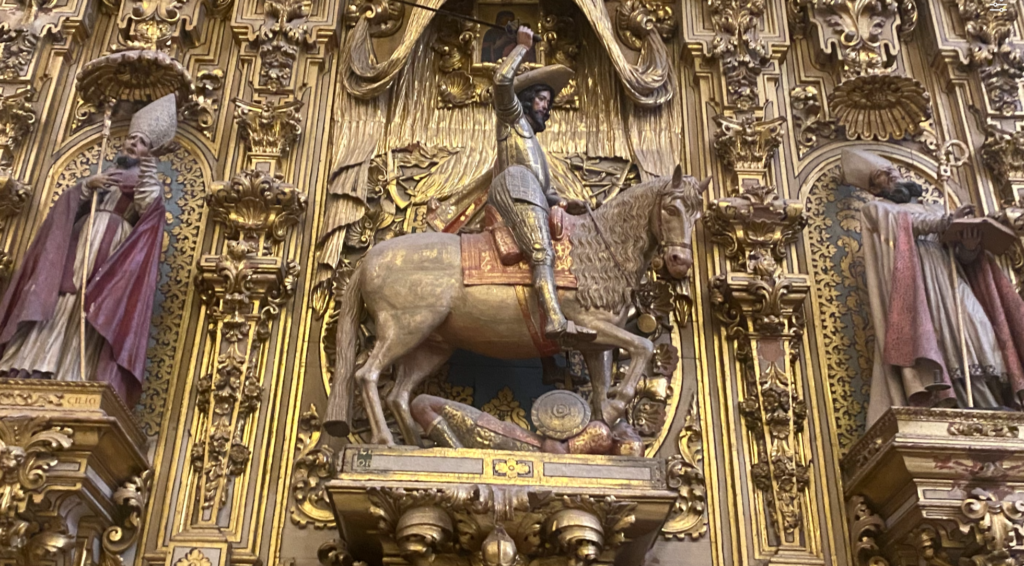- Facebook105
- Twitter2
- Total 107
Two stories compete in the imagination of Spain and Portugal, affecting how history is portrayed in schools, on public monuments, and in policy debates about matters like immigration. The stakes are high because the former story played an important role in the invention of the concept of race and thus helped to enable imperialism and transatlantic slavery.
First story: The original Iberians were Europeans who became citizens of the Roman Empire, speaking dialects of Latin that evolved into today’s Spanish, Portuguese, and Catalan, and who converted early to Christianity. In and after 711, a foreign army conquered Spain. These invaders originated in Africa and the Middle East, their religion was Islam, and their language and culture were Arabic. Gradually, the Spanish and Portuguese drove these invaders out.

Second story: The inhabitants on both sides of the western Mediterranean were never sharply distinguished. Many on both sides became Romanized and Latin-speaking. Most converted to a religion of Middle Eastern origin, Christianity. Then, many converted to another religion from the same region, Islam. The leaders of the armies that traveled a short distance across the straits in 711 were Muslims, but their armies were of mixed faiths. A substantial proportion of people on either side of the straits assimilated to–and influenced–a broad cultural/linguistic group called the Arabs. Among those who contributed to Arab culture were Iberians of Christian or Jewish faith. Gradually, some dynasties that identified as Christian and spoke Spanish displaced those that identified as Muslim and Arab, and the former cultural influences predominated. Today’s Spaniards (as a group) have forebears who were Muslims and Arabs or Jews. Typically, people stay in place while cultures spread.
An 18th-century Carthusian monk took 30 years to make this door. It stands in an extravagantly decorated baroque chapel inside a gilt-draped Catholic monastery in Granada. The similarity to Mudejer art is unmistakable, and surely Brother Jose Manuel was practicing the art of his Arabized forebears.

The two models are reconquista (reconquest) and conviviencia (coexistence). With these two models in mind, consider the following document. In 1038, Fernando I of Castille wrote to Isma’il ibn Dhi ‘l-Nun, the king of Toledo, who had sought his support in a war against Isma’il’s kinsman. Fernando wrote:
We… demand our land, which a long time ago you conquered and which you have inhabited for as long as had been ordained [by God]. Now He has given us victory over you on account of your wickedness. Depart to your own shores and give our land up to us. For there is no good in your living with us any longer, nor will we turn away from you until God has judged between you and us.
(translated by Catlos 2018, p. 211)
This letter looks like evidence of reconquista. A leader of Christian Spain is demanding that foreign invaders go back home. Indeed, Fernando was called (although not by himself), the Emperor of Spain. His opponent was the reigning head of the Dhulnunid or Dhunnunid dynasty, which traced its origins to members of the conquering army in 711.
But, to complicate matters … both of these men spent much of their lives at war against rivals who were a mix–in both cases–of Christians and Muslims. Fernando’s better-documented son, Alfonso VI (El Bravo) was raised and educated by his father’s allies, the Banu Gómez clan. This dynasty was Christian (at least at this time), but their name is Arabic. Later, Alfonso took refuge for a while at the court of al-Mamun of Toledo, a Muslim. One of Alfonso’s wives was Zaida of Seville, who was probably the daughter-in-law of the ruler Al-Mu’tamid Muhammad, who claimed patrilineal descent from an Egyptian clan. Zaida was the mother of Alfonso’s son and heir, Sancho Alfnónsez, who was thus the descendent of both Fernando and Al-Mu’tamid. Alfonso VI lived a long and bloody life, fighting his own brother and other Christian monarchs as well as Muslim ones in various mixed alliances. When he captured Toledo from al-Mamun’s heir, he took the title al-Imbratur dhi-l-Millatayn: “Emperor of the Two Religions” and promised to maintain the city’s mosque. This is evidence of conviviencia, not reconquista.

I am not qualified to interpret Fernando’s 1038 letter, but I’d suggest reading it (and the whole history of its era) without such anachronistic ideas as racial differences or even “Europe.”
It’s at least possible that Fernando was not saying: “You and your people, go back to Africa.” Instead, he might have meant: “O leader of the Dhulnunid House, your proper feudal fiefdom is in Mauretania, where your first-known patrilineal ancestor once ruled. Go back to your own demesne, because Toledo belongs to my House, the Jimenez dynasty, also known as the Banu Sancho, and leave your vassals here for me to rule. You and I are peers and are probably kin. However, God recognizes my claim to this specific land, so be gone.”
To be sure, a Spanish identity developed that was religious, gradually racial, and defined as the opposite of an imposed “Moorish” identity. (See the first image, above.) But that happened over centuries–in part to serve political agendas–and we should be cautious about using it as an interpretive framework except when the evidence supports it.
Source: Brian A. Catlos, Kingdoms of Faith (Basic Books, 2018), but I collected the biographical details and art in the post. See also: Europa was an Asian woman, and other thoughts on the definition of Europe; the history of the phrase “the West”; don’t name things Western but call out imperialism; to whom do the ancient Greeks belong?; Jesus was a person of color; etc.